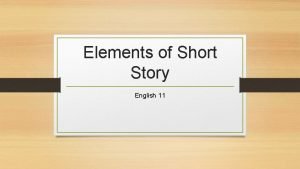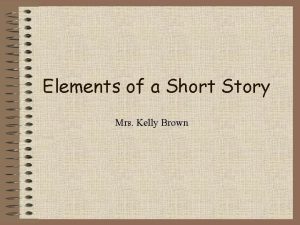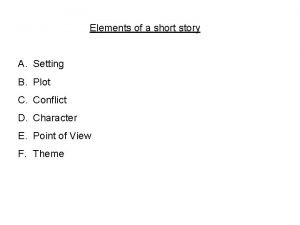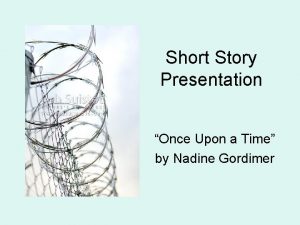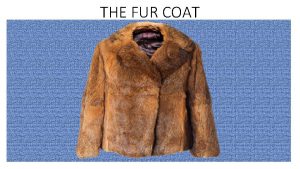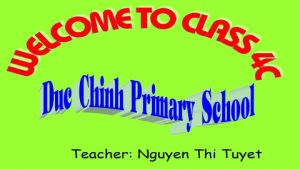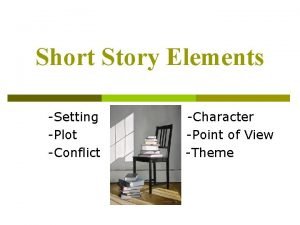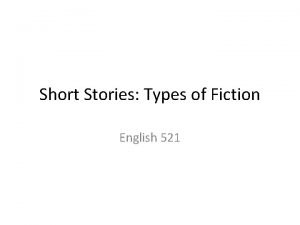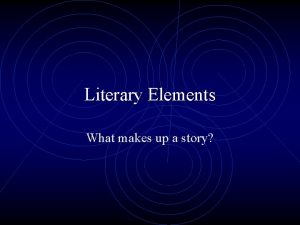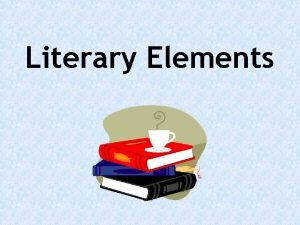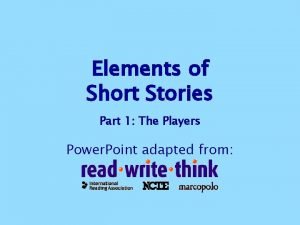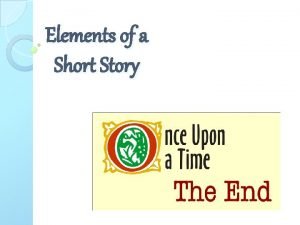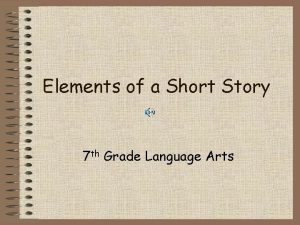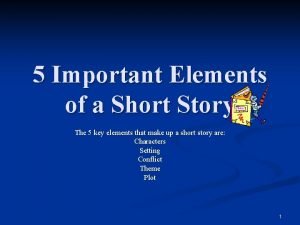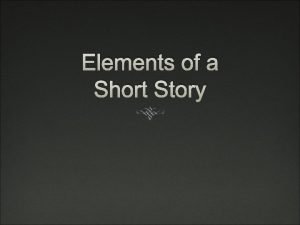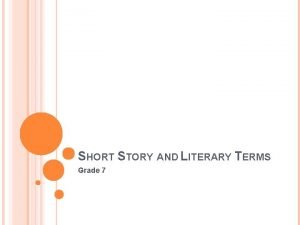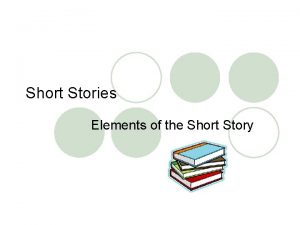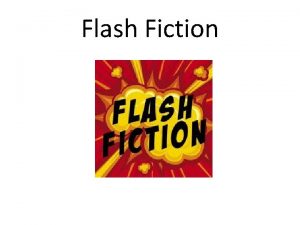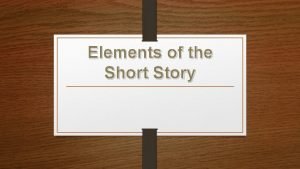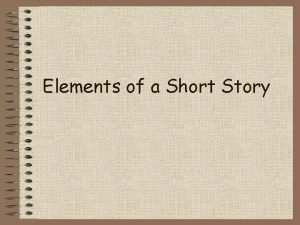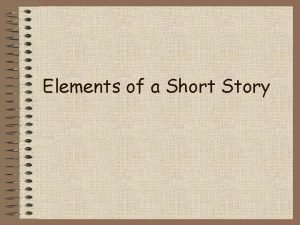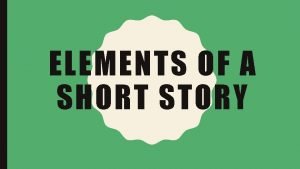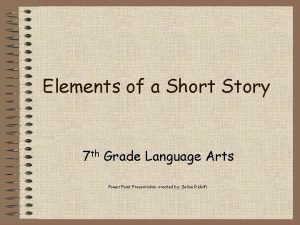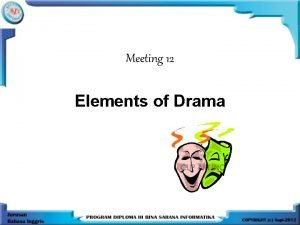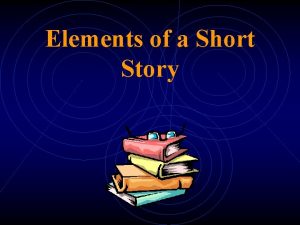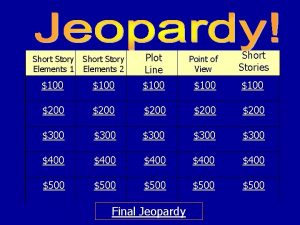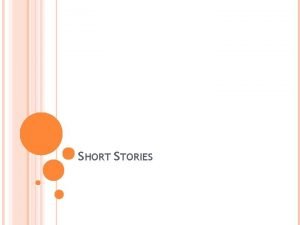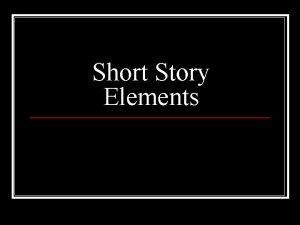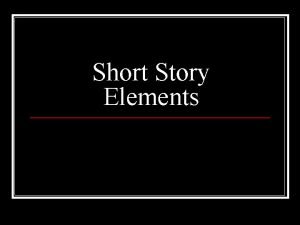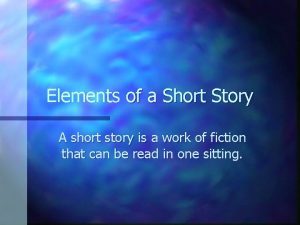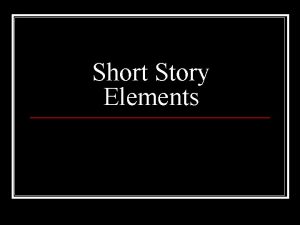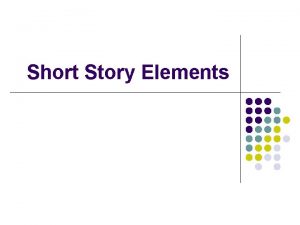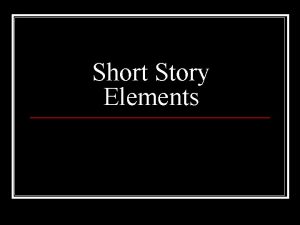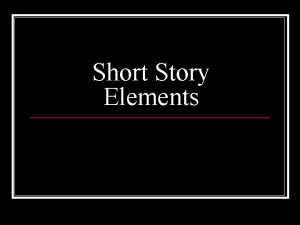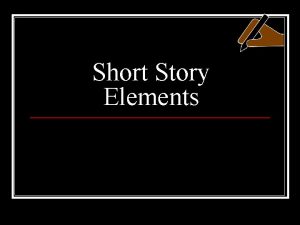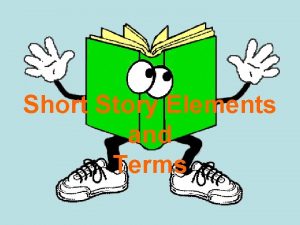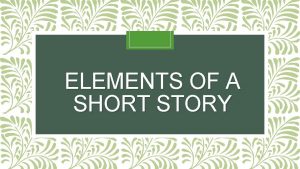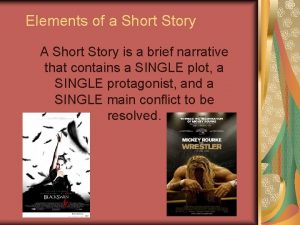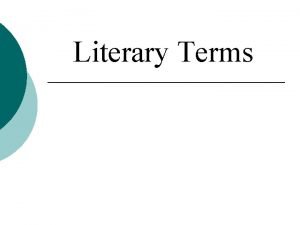Elements of Short Story English 11 Five elements


























- Slides: 26

Elements of Short Story English 11

Five elements to a short story • http: //youtu. be/c 6 I 24 S 72 Jps 1. Plot 2. Character 3. Conflict 4. Theme 5. Setting

Purpose • Short stories combine the purpose of entertaining with that of revealing life. • Purposes of short stories: 1. 2. 3. 4. 5. To entertain Provide Insight To Question Presents a view of life Provides a set of values

Purpose • NOTE: thinking about the purpose of the story is important because it leads us beyond the surface of qualities to consider the meaning, value, and success of the story • These purposes are achieved through short story elements such as 1. Plot 2. Characters 3. Themes 4. Setting 5. Conflict

Purpose Stories that are intended for escape focus on: 1. Plot 2. Conflict 3. Suspense 4. Humor Interpretive Stories focus on: 1. Theme 2. Character

Plot

Plot • Serves as the framework for the story • It is the action that takes place within the story • Has five main features: 1. Introduction 2. 3. 4. 5. Rising Action Climax Falling Action Conclusion • These events within the story generally focus on one dominant incident

Plot – Introduction/Exposition • • • Should grab the reader’s interest Gives background information Introduces the main characters Introduces the setting (time and place) May suggest a possible ending (flashback or foreshadowing) Initial incident takes place to get the story going

Plot – Rising Action • Series of steps that develop and show an obstacle or problem in a story • Largest part of the plot • The clash or fight between opposing forces/persons/ideas/emotions

Plot - Climax • Highest point of interest in the story (the big battle) • Turning point of the story or change in action • Often the problem or mystery is about to be solved

Plot – Falling Action or Dénouement • • • The “unknotting” of plot and conflict following the climax Follows quickly after the climax and lasts until the end of the story Ties up all loose ends in a story All questions answered and problems solved Sometimes the author leaves the ending to the reader’s imagination (open ended story) • Example: At the end of Harry’s fight with Voldemort, Harry and Dumbledore often recall the year’s events and Dumbledore answers’ Harry’s questions

Plot - Conclusion • Usually the last paragraph or last couple of sentences to draw a story to a close

Setting • Where and when does the story take place? • Describe the area as a whole but be specific about all the little details. • It needs to create a concrete image in the reader’s mind.

Setting Picture Activity • Select one picture from the next slide, create a vivid setting that creates a clear image in the reader’s mind. Be specific! A small town Seba Beach is a quaint town in central Alberta with a year round population of only 500. It’s the type of town where everyone knows your name and a trip to the store is as much a social event as it is a chore. 1930’s The year is 1931, the prosperous times of the 1920 s are over and although there is very little of anything to go around the people of Seba Beach don’t let it get them down.


Theme • What is the deeper message the author is trying to give? • Theme is universal it exists in a variety of settings with a variety of characters. • Novels can have more than one theme. • Fairytales and Fables have specific lessons as their theme. • Examples: • Cherish your family. • Think for yourself. • Perseverance pays off. • Read the Fable and determine what theme is

Theme • The central idea of a story that is usually implied rather than directly stated. • Theme is a generalization made about life • It is not the moral or plot of the story • To find theme of a story, novel or play • • Look at how the main character(s) has changed Look at the central conflict and outcome of that conflict Look at the story, novel, or play’s title for clues Consider #1 -3 as a whole, not separately

Example of Theme • One theme in “Cinderella” is that the good shall be rewarded. This is illustrated when Cinderella, cruelly treated by her step-sisters and step-mother, continues to be kind and patient. Her perseverance and good nature is rewarded when the she attends the ball and marries the prince • Notice I use specific events (quote if able) to help support my idea that those who are kind and good will be rewarded.

Conflict • Conflict is a struggle to understand something, to solve a problem, to reach a goal, or to satisfy a need • It may be physical, mental, emotional, moral or a combination of types • It may not have a clear outcome of who is the winner or the loser in the struggle • Two main categories: external and internal conflict

Conflict • Internal • Person vs. Self – the character is dealing with an inner struggle; for example, addiction, body image issues, self-doubt, etc. . • Person vs. self • External – a character is struggling against factors • Person vs. Person • Person vs. Society • Person vs. Nature • Person vs. Supernatural

Characters • Protagonist • The main character. Usually a good person with admirable qualities who acts as a hero. If they do not have admirable qualities, they are known as the anti-hero • Antagonist • The main force against the protagonist. The villain • Character Foil • Someone who has contradictory characteristics to the protagonist. The reader learns more about the protagonist by seeing them contrasted next to the character foil Using the Harry Potter series, which characters fit in these categories?

Characters • Dynamic • A dynamic character is a person who changes over time. Usually central characters are dynamic. The change is important to the character’s personality and development. Change comes from a crucial situation in the character’s life. • Round • A rounded character is anyone who has a complex personality; he or she is often portrayed as a conflicted and contradictory person • Flat Character • Only see one side of the character. Not a developed character. Usually minor character within the story • A flat character is the opposite of a round character. This literary personality is notable for one kind of personality trait or characteristic.

Characters • Static • The character undergoes no change in the story. This type of character will remain the same from the beginning to the end of the story • Stock • characters are those types of characters who have become conventional or stereotypical. Stock characters are instantly recognizable to readers or audience members • • Also known as a stereotyped character Usually a flat character Occurs so often in literature that the character and his/her traits are easily recognized. Example: Mad scientist, Wicked Witch or Stepmother, Jock

• 1 st Point of View Person = the narrator is a character and refers to themselves as “I”. • 3 rd Person Limited Omniscient = the narrator is not a character but their knowledge is limited to that of one character. Refers to the main character as “he” or “she. ” Shows the reader only what one character thinks or feels in the story. • 3 rd Person Omniscient = the narrator knows everything about all the characters. • Omniscient = one having total knowledge

• Flashback Literary Techniques • Returning to a prior event mid story. • Foreshadowing • Clues that help the reader predict what will happen next. • Irony http: //theoatmeal. com/comics/irony • Verbal – saying one thing but meaning the opposite. • Situational – a reversal of expectations. • Dramatic – when the audience knows what is going to happen before the character clues in. • Mood and Tone • How the story makes the reader feel. The atmosphere established in the story.

Literary Techniques • Symbol: something that stands for or represents something else • White dove represents peace • Red rose represents love • Suspense: the feeling of anxiety and uncertainty experienced by the reader about the outcome of events within a piece of literature. An author will try to keep a reader guessing • Contrast: looking at the differences in things, people, ideas. Comparing one thing to another. Missing of situations, characters, settings, moods, tones, or points of view in order to clarify meaning, purpose, of characters within literature
 Tall+short h
Tall+short h Five elements of short stories
Five elements of short stories Short stories
Short stories Five elements and five senses
Five elements and five senses Short story with complete elements
Short story with complete elements Elements of a short story
Elements of a short story Once upon a time short story
Once upon a time short story The fur coat summary short story
The fur coat summary short story Cat and mouse short story
Cat and mouse short story Setting character plot conflict theme
Setting character plot conflict theme Sjort story
Sjort story Elements of a short story video
Elements of a short story video Short story literary elements
Short story literary elements Elements of a short story powerpoint
Elements of a short story powerpoint Elements of a short story
Elements of a short story What are the 7 elements of a short story?
What are the 7 elements of a short story? 5 element of a short story
5 element of a short story Identify the elements of short story. *
Identify the elements of short story. * Story telling piece for grade 7
Story telling piece for grade 7 Elements of short stories vocabulary
Elements of short stories vocabulary Flash fiction and short story elements
Flash fiction and short story elements Story with plot diagram
Story with plot diagram Resolution elements of a story
Resolution elements of a story Elements of a story definition
Elements of a story definition Definition of short story
Definition of short story Elements of the story
Elements of the story Basic elements of drama
Basic elements of drama

